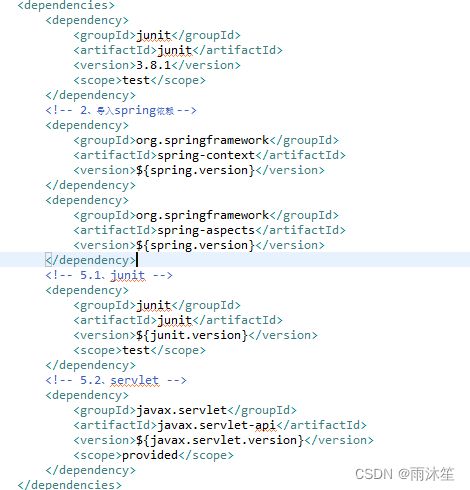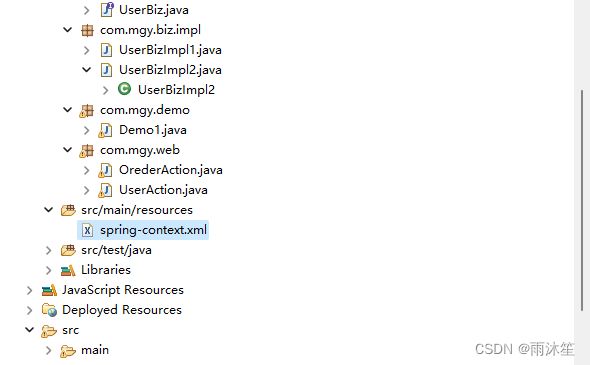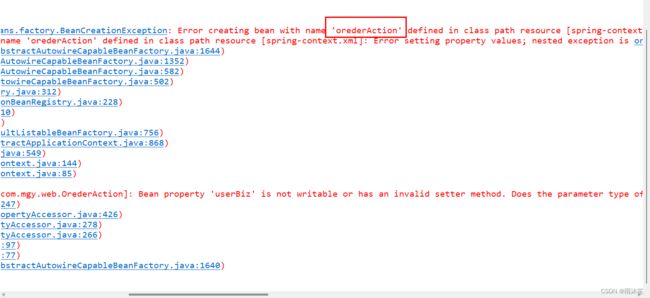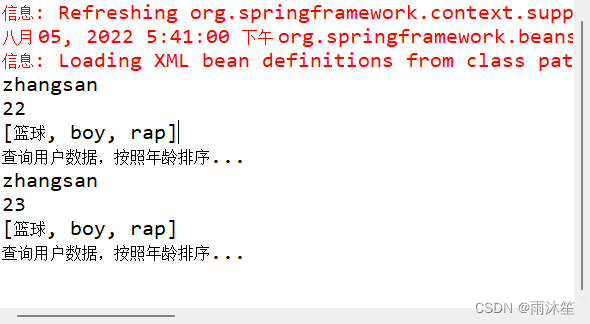Spring(ioc)
目录
一、Spring
二、Spring中ioc的特点
三、依赖注入的3种方式
1.set注入
2.构造注入
3.自动装配
3.3.1 byName
3.3.2 byType
四、Spring与web容器的整合
一、Spring
Spring是一个开源框架,它由Rod Johnson创建。它是为了解决企业应用开发的复杂性而创建的。
Spring使用基本的JavaBean来完成以前只可能由EJB完成的事情。
然而,Spring的用途不仅限于服务器端的开发。从简单性、可测试性和松耦合的角度而言,任何Java应用都可以从Spring中受益。目的:解决企业应用开发的复杂性
功能:使用基本的JavaBean代替EJB,并提供了更多的企业应用功能
范围:任何的Java应用
简单来说,Spring是一个轻量级的控制反转(IOC)和面向切面(AOP)的容器框架。
二、Spring中ioc的特点
先建立一个maven项目将以下代码加入到maven项目中的pom.xml中
5.0.1.RELEASE
4.0.0
4.12
加入改代码块的是为了将当前项目jar依赖版本定义在外部,目的在于所有jar包版本进行统一管理
再将 以下代码块加入其中,替换掉原来
junit
junit
3.8.1
test
org.springframework
spring-context
${spring.version}
org.springframework
spring-aspects
${spring.version}
junit
junit
${junit.version}
test
javax.servlet
javax.servlet-api
${javax.servlet.version}
provided
后面的步骤和昨天配置的步骤一样,可以前往配置maven
在开发的时候,往往有这样的场景,有这样一个接口,里面放置的方法为增删改查等;需求:同时在用户模块、订单模块拿到所有的用户数据,并且要求用户数据是已经通过年龄排序了的,然而根据之前所学的对应策略:修改userBiz(业务层)中的方法,添加排序功能。但如果需求又发生改变呢?就可以想到多实现的方法。
可以总结一下:
最原始:频繁修改业务层biz层代码,这样bug容易很多。
多实现:凡是涉及到用户业务层调用的地方,都需要修改代码
将以下xml文件加入到src/main/resources中
UserAction:
package com.mgy.web;
import com.mgy.biz.UserBiz;
import com.mgy.biz.impl.UserBizImpl1;
public class UserAction {
// private UserBiz userBiz=new UserBizImpl1();
private UserBiz userBiz;
public UserBiz getUserBiz() {
return userBiz;
}
public void setUserBiz(UserBiz userBiz) {
this.userBiz = userBiz;
}
public void list() {
userBiz.list();
}
}
该类和OrederAction一样的代码
将之前写的业务层和web加入到之中进行配置,切记要联网
Demo1:
package com.mgy.demo;
import org.springframework.context.support.ClassPathXmlApplicationContext;
import com.mgy.web.OrederAction;
import com.mgy.web.UserAction;
/**
* 1.对Spring框架的配置晚间进行建模,建模之后,spring-context.xml中所有的Javabean信息都会加载进Spring容器的上下文中
* 2.上下文中就包含spring-context.xml 所有对象
* @author Administrator
*
* IOC的特点-什么叫控制反转
* 指的是将创建对象的权力反转给Spring容器来完成
*
*/
public class Demo1 {
public static void main(String[] args) {
//建模
ClassPathXmlApplicationContext context = new ClassPathXmlApplicationContext("/spring-context.xml");
UserAction userAction = (UserAction) context.getBean("userAction");
userAction.list();
OrederAction orederAction=(OrederAction)context.getBean("orederAction");
orederAction.list();
}
}
效果:
之后就只需要修改spring-context.xml文件的中的第一行就可以了。
三、依赖注入的3种方式
将其中一个action中的get和set方法注销后会产生报错
错误:
1.set注入
将其中一个action类加入字段,并且给set和get方法
package com.mgy.web;
import java.util.List;
import com.mgy.biz.UserBiz;
import com.mgy.biz.impl.UserBizImpl1;
/**
* 依赖注入的3种方式:
* 1.set注入
* 2.构造注入
* 3.自动装配
* @author Administrator
*
*/
public class UserAction {
// private UserBiz userBiz=new UserBizImpl1();
private UserBiz userBiz;
public UserBiz getUserBiz() {
return userBiz;
}
public void setUserBiz(UserBiz userBiz) {
this.userBiz = userBiz;
}
private String name;
private int age;
private List hobby;
public String getName() {
return name;
}
public void setName(String name) {
this.name = name;
}
public int getAge() {
return age;
}
public void setAge(int age) {
this.age = age;
}
public List getHobby() {
return hobby;
}
public void setHobby(List hobby) {
this.hobby = hobby;
}
public void list() {
System.out.println(name);
System.out.println(age);
System.out.println(hobby);
userBiz.list();
}
}
在去xml种进行配置
篮球
boy
rap
property该标签没有list这个属性,所以要在该标签内部进行
效果图:
2.构造注入
将字段给入构造方法,切记要给入无参的构造方法
package com.mgy.web;
import java.util.List;
import com.mgy.biz.UserBiz;
import com.mgy.biz.impl.UserBizImpl1;
public class OrederAction {
// private UserBiz userBiz=new UserBizImpl1();
private UserBiz userBiz;
public UserBiz getUserBiz() {
return userBiz;
}
public void setUserBiz(UserBiz userBiz) {
this.userBiz = userBiz;
}
private String name;
private int age;
private List hobby;
public OrederAction() {
// TODO Auto-generated constructor stub
}
public OrederAction(String name, int age, List hobby) {
super();
this.name = name;
this.age = age;
this.hobby = hobby;
}
public void list() {
System.out.println(name);
System.out.println(age);
System.out.println(hobby);
userBiz.list();
}
}
xml文件中的配置,构建注入配置和set注入的配置是不一样的
篮球
boy
rap
效果:
3.自动装配
3.3.1 byName
根据spring中的id进行查询的,如果找不到则出现报错,反之成功
xml文件:
篮球
boy
rap
篮球
boy
rap
效果:
3.3.2 byType
根据spring中的bean对象接口实现类进行查询的,如果找不到或出现两个则出现报错,反之成功
将上面的byName给成byType就可以了
四、Spring与web容器的整合
Spring与web容器的整合原理
why:建模的过程十分耗时的
how:
解决问题:
1.建模比不可少
2.建模要保障只执行一次
3.建模后期望在每一个servlet都能够拿到Spring的上下文对象ClassPathXmlApplicationContext
how:
1.监听器(里面初始化只执行一次)
2.Spring的上下文要存放在Tomcat上下文中
package com.mgy.biz.listener;
import javax.servlet.ServletContext;
import javax.servlet.ServletContextEvent;
import javax.servlet.ServletContextListener;
import org.springframework.context.support.ClassPathXmlApplicationContext;
import com.mgy.web.UserAction;
/**
* 1.实现监听器
* 2.初始化方法contextInitialized
* 3.拿到Tomcat上下文
* 2.将Spring上下文保存到Tomcat上下文中
*
* @author Administrator
*
*/
public class SpringLoadListener implements ServletContextListener{
@Override
public void contextInitialized(ServletContextEvent sce) {
System.out.println("初始化");
ServletContext servletContext = sce.getServletContext();
//自定义配置文件
String aa = servletContext.getInitParameter("applicationContext.xml");
System.out.println(aa+"///拿到了自定义配置文件");
//拿到Spring上下文(包含所有javabean)
ClassPathXmlApplicationContext context = new ClassPathXmlApplicationContext("/spring-context.xml");
//将Spring上下文保存到Tomcat上下文中
//applicationContext.xml
servletContext.setAttribute("springContext", context);
}
}
然后我们配置到web服务器上,顺便把定义项目名也配置了
Archetype Created Web Application
springconfiglocation
/applicationContext.xml
com.xlb.biz.ioc.listener.SpringLoadListener
然后我们写一个实现类web层DemoServlet.java
package com.mgy.demo;
import java.io.IOException;
import javax.servlet.ServletException;
import javax.servlet.ServletRequest;
import javax.servlet.ServletResponse;
import javax.servlet.annotation.WebServlet;
import javax.servlet.http.HttpServlet;
import org.springframework.context.support.ClassPathXmlApplicationContext;
import com.mgy.web.UserAction;
/**
* Spring与web容器的整合原理
* why:建模的过程十分耗时的
* how:
* 解决问题:
* 1.建模比不可少
* 2.建模要保障只执行一次
* 3.建模后期望在每一个servlet都能够拿到Spring的上下文对象ClassPathXmlApplicationContext
*
* how:
* 1.监听器(里面初始化只执行一次)
* 2.Spring的上下文要存放在Tomcat上下文中
*
* @author Administrator
*
*/
@WebServlet("/springDemo")
public class DemoServlet extends HttpServlet{
@Override
public void service(ServletRequest req, ServletResponse res) throws ServletException, IOException {
//建模
//1、spring-context.xml模型对象
//ClassPathXmlApplicationContext context = new ClassPathXmlApplicationContext("/spring-context.xml");
ClassPathXmlApplicationContext context = (ClassPathXmlApplicationContext)req.getServletContext().getAttribute("springContext");
//拿到UserAction
UserAction userAction = (UserAction)context.getBean("userAction");
//调用方法
userAction.list();
}
}









